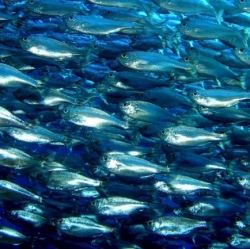
Illicit fishing goes on at an industrial scale. But commercial fishers are about to get a new set of overseers: conservationists, and soon the general public, armed with space-based reconnaissance. Crews on big fishing boats deploy an impressive arsenal of technology, from advanced sonars to GPS navigation and mapping systems, as they chase down prey.
These tools are so effective that roughly a third of the world’s fisheries are now overharvested, and more than three-quarters of the stocks that remain have hit their sustainable limits, according to the FAO. For some species, most of the catch is unreported, unregulated, or flat-out illegal.
But now environmentalists are using sophisticated technology of their own to peel away that cloak of invisibility. With satellite data from SpaceQuest and financial and engineering support from Google, two environmental activist groups have built the first global surveillance system that can track large fishing vessels anywhere in the world.
A prototype of the system, called Global Fishing Watch, was unveiled today at the IUCN World Parks Congress in Sydney. The tool makes use of Google’s mapping software and servers to display the tracks followed in 2012 and 2013 by some 25,000 ships that were either registered as large commercial fishers or were moving in ways that strongly suggest fishing activity.
